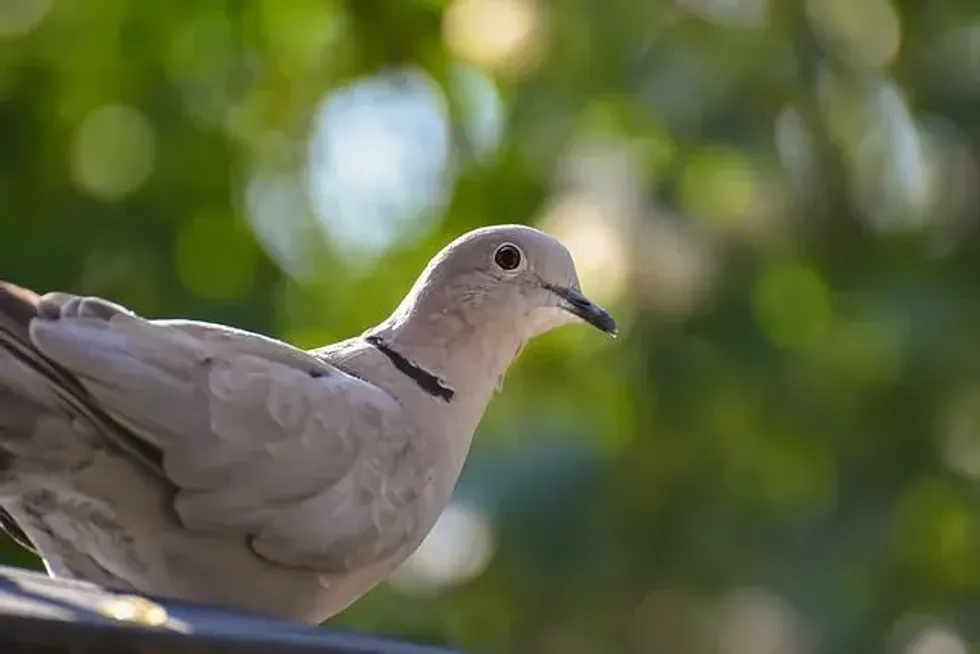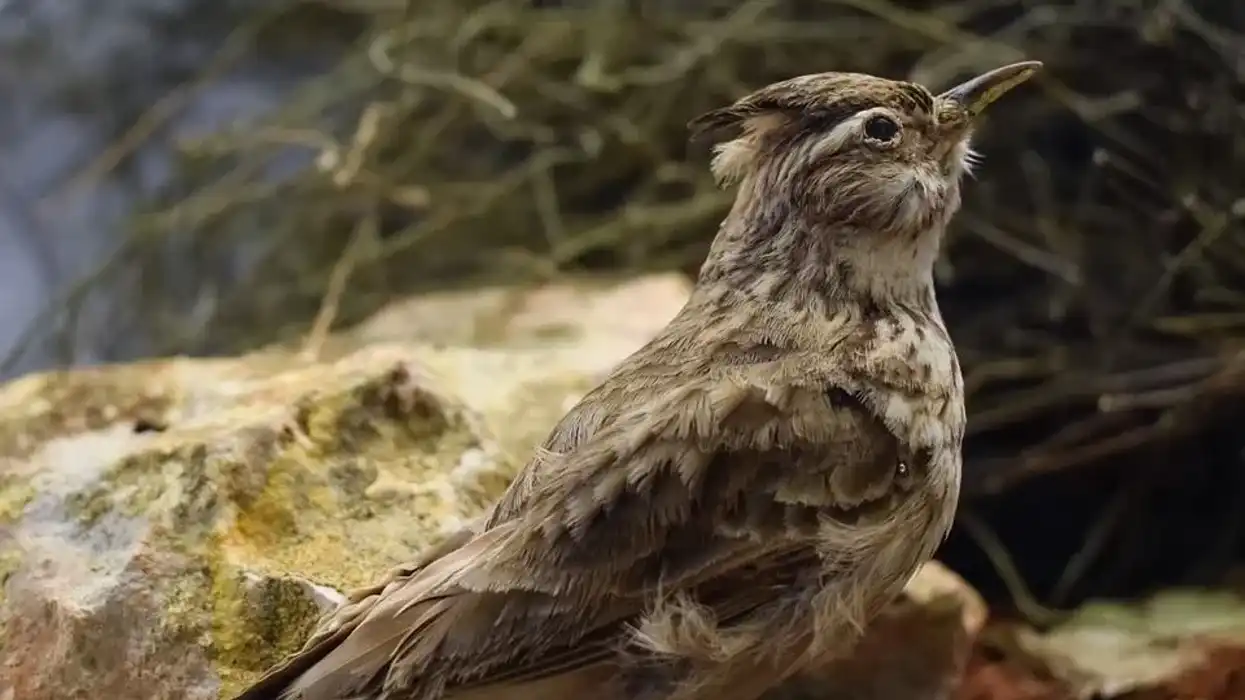The Eurasian collared dove is a pigeon species that is native to Europe and Asia and was introduced in the '70s to the Bahamas. This species of pigeon is now found in most parts of the world, including the Middle East, Europe, Asia, North America, and the Caribbean islands but it is not in areas with extreme cold temperatures.
Eurasian collared dove ranges have spread to Florida in the U.S., and neighboring regions too.
This dove species is often light brown in color with black, gray, and white wings. The bird is currently in the Least Concern classification when it comes to its conservation status and is known to be increasing in population at a rapid pace.
Eurasian collared doves attain sexual maturity at the age of one year and mate with partners during their breeding season when it's warmest. A female lays two eggs that are taken care of by both parents to protect them.
If you like reading these facts, you can also check out more facts on dove and robin birds.
Eurasian Collared Dove Interesting Facts
What type of animal is a Eurasian collared dove?
The Eurasian collared dove (Streptopelia decaocto) is a bird that belongs to the class of Aves. They are a medium-sized species of dove whose population across the globe is currently in huge numbers.
What class of animal does a Eurasian collared dove belong to?
This species of dove belongs to the class of Aves (birds). Just like most other birds, Eurasian collared doves lay eggs and raise young birds who live in nests. Collared dove species are from Europe and Asia and are also found in many different areas like North America and the Caribbean Islands too.
How many Eurasian collared doves are there in the world?
The current conservation status of this bird is Least Concern as there are so many birds of this species present across the world. According to estimates, there are upward of 50 million birds of this kind present across the world today.
The Eurasian collared dove (invasive species) is found in many parts of China, Korea, and around 45% of the total population is located in Europe.
Where does a Eurasian collared dove live?
The Eurasian collared dove range is from Europe to Japan, the Middle East, North America, and the Caribbean islands. The bird is typically found living in urban and suburban areas throughout North America and Eurasian collared doves are mostly seen living near big trees and silos but tend to avoid dense forests and areas with extreme cold.
These birds are also often seen living near farming ground areas and yards where food grains and parts of their diet are easily available.
What is a Eurasian collared dove's habitat?
This North American species is generally dependent on seeds, fruits, food grains, and a few invertebrates for food, found in most parts of the U.S. and beyond, including the Bahamas. But since they cannot withstand extremely cold conditions and so they avoid northern areas of the globe.
The typical Eurasian collared dove habitat includes places like grasslands and farms, in both suburban and urban regions. This species eludes dense forests and mostly lives on tall trees.
Who do Eurasian collared doves live with?
The Eurasian collared dove (Streptopelia decaocto) species is generally seen living in pairs. These doves are monogamous, forming mating pairs during their breeding season, and they can consistently breed in warm regions.
How long does a Eurasian collared dove live?
These North American birds tend to live for three years in the wild, but the oldest one recorded was 17 years old. Eurasian collared doves become sexually mature when they are one year old and then go on to form a breeding pair that breeds in warmer regions in the years to come.
How do they reproduce?
Eurasian collared doves are monogamous in nature and can breed continuously in warm regions. They find partners and form partnerships that mate and take care of offspring together.
These species attain sexual maturity at the age of one year. A Eurasian collared dove nest is made with twigs, grass, feathers, strings, and wool, and each nest is used multiple times in a year.
A female lays about two eggs at a time, which females took care of in the daytime and males look after from night until dawn.
The eggs finally hatch after an incubation period of about 14-19 days. Parents then feed their newborn Eurasian collared dove nestlings for about three weeks before they can begin to fend for themselves.
What is their conservation status?
The current conservation status of this species of birds is Least Concern, with their current population worldwide estimated to be more than 50 million individuals. These birds are seen to be increasing in numbers rapidly and are found in almost all major parts of Europe and North America as well as elsewhere around the world.
Eurasian Collared Dove Fun Facts
What do Eurasian collared doves look like?
These North American birds have small heads, plump bodies, and a long tail. They are colored light brown with white, gray, and black wings and patches on their body.
Their wings are slightly rounded and broad, while their tail tip is squared off, rather than being pointed. They have a white tuft of feathers below their chest region and are therefore often known as a white Eurasian collared dove.
There's also known to be a black half collared dove with a black-colored crescent around the nape of their neck. The tail feathers of these fine birds are generally known to be long.
How cute are they?
A Eurasian collared dove (Streptopelia decaocto) is somewhat cute by its appearance. Eurasian collared doves come in gray, black, white, and light brown colors with a short head and long tail, making them look quite beautiful. What's more, these birds are known to have a friendly nature towards humans, making them that little bit cuter!
How do they communicate?
The Eurasian collared dove call sounds like 'coo-coo-coo' and is knows as the Eurasian collared dove's song or the Eurasian collared dove sound. They also do screech at times, the Eurasian collared dove screech is quite harsh and loud.
How big is a Eurasian collared dove?
The typical Eurasian collared dove size is about 13 in (32 cm) long, and they weigh roughly between 4.4-8.5 oz (125-240 gm). Eurasian collared doves are generally much bigger than American mourning doves.
How fast can a Eurasian collared dove fly?
The Eurasian collared dove species can fly at a pretty respectable speed of up to 37 mph (60 kph). Likewise, the back half collar dove too can fly at similar speeds. They can fly as far as 373 miles (600 km) when they are young.
How much does a Eurasian collared dove weigh?
The Eurasian collared dove is a medium-sized pigeon species that generally lives on trees and farmlands. The weight of this pigeon ranges from 4.4-8.5 oz (125-240 gm).
If we are looking at the Eurasian collared dove vs. mourning dove, then it is important to note that this species of pigeon (Eurasian collared dove) is known to be bigger in size and heavier than the mourning dove.
What are their male and female names of the species?
A Eurasian collared dove (Streptopelia decaocto) male is referred to as a 'cock', and a female Eurasian collared dove is called a 'hen'.
What would you call a baby Eurasian collared dove?
A Eurasian collared dove nestling is referred to as a 'squab' or 'squeaker', just like a black half collar dove baby or any other collared dove offspring.
What do they eat?
The average Eurasian collared dove diet consists of both insects and fruits. The population of Eurasian collared doves is most often seen feeding on grains, seeds, fruits, and even other invertebrates. The Eurasian collared dove itself is primarily hunted by hawks.
Are they harmful?
Sometimes, although they generally have a friendly nature toward humans, this European bird can be very aggressive as it is very territorial. With the Eurasian collared dove, problems are inevitable.
These birds can be extremely harmful to other dove species and to the hawks that prey on them as well, as they carry Trichomonas gallinae, a disease-causing parasite that can cause serious health problems.
Would they make a good pet?
No, although the Eurasian collared dove is friendly and shares a good bond with humans, these birds can be aggressive and territorial. Moreover, they carry a disease-causing parasite that can cause serious health issues to fellow pigeon family members and predators like hawks.
Did you know...
These birds are bigger in size when compared to the mourning dove but slimmer than the rock-tailed pigeon and have longer tails too.
Eurasian collared dove hunting without a license and legal permission from authorities is a punishable offense.
To get rid of a Eurasian collared dove, you can hang plastic in the shape of different animals, the larger the better, on a balcony and between agricultural fields. This should act as a deterrent to keep them away from eating grains.
Decaocto is the species name of the Eurasian collared dove. It got its name from the Greek gods who transformed a female servant into a dove so that she could escape her unhappy life, and the mournful cry that the dove makes is seen as symbolic of her recalling her former life.
Where did the Eurasian collared dove come from?
Eurasian collared doves were introduced to the Bahamas in the '70s. These collared doves are native of Europe and Asia and were later introduced to other areas like the Caribbean islands, Japan and North America.
Why is the Eurasian collared dove bad?
The Eurasian collared dove is an invasive species in the U.S. and it poses a unique problem to the environment. This is because they are known to carry a disease-causing parasite that is easily transferred to other dove species, capable of killing both their predators (such as hawks) and fellow dove species.
Here at Kidadl, we have carefully created lots of interesting family-friendly animal facts for everyone to discover! Learn more about some other birds including the least tern, or the kestrel bird.
You can even occupy yourself at home by drawing one on our Eurasian collared dove coloring pages.










